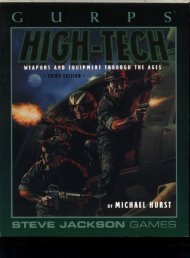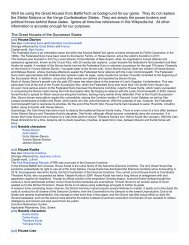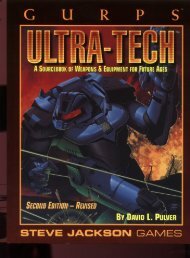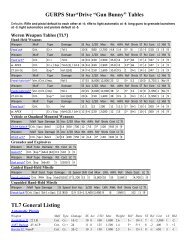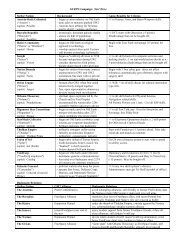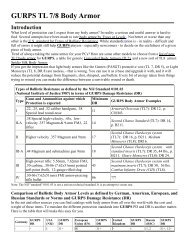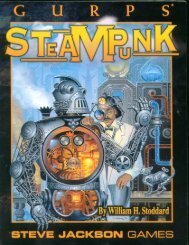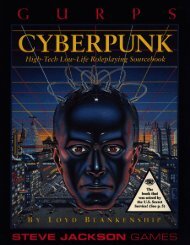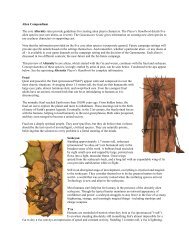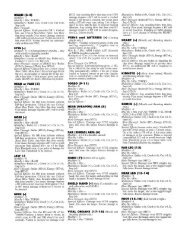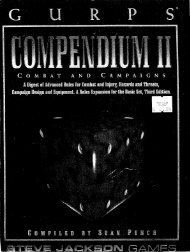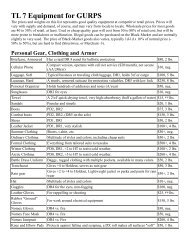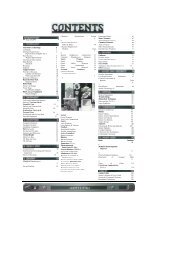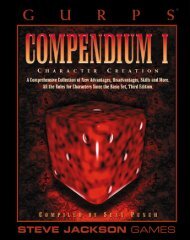If you are using the "hit location" rules, you may target specific parts of the body(e.g., the head), at specific "to hit" penalties. Do not add these penalties to the ones listedabove unless some extra difficulty is really being added. Example: If only the target'shead is showing, the penalty to hit it is the same -5, whether you consider it "aiming at thehead because you want to," or "aiming at the head because that's all that's exposed."OvershootingIf you make your attack roll, but your foe blocks or parries successfully, your weapon ormissile has been knocked to the floor. There is no chance that you hit anyone.If your foe dodges, the weapon/missile went past him and may hit someone else.Proceed as above, but start with the closest character on the other side of your foe. (Youalready know you didn't hit anybody between you and your foe. or he would not havehad to defend.)ScatterWhen you throw a grenade or similar object, you may say that you are "lobbing" itwith a high trajectory rather than throwing it in a straight line. You still pick one hex toaim at, and make your attack roll in the usual way. But you need not worry about anybodywho might be in your way. And if you miss, your grenade will hit fairly close ratherthan shooting past!If you miss your attack roll, you missed your target by a number of yards equal tothe amount by which you missed your roll - or half the distance to the target, whichever isless. Round up.To determine the direction of your miss, roll one die. Take the direction you arefacing as #1. the next direction clockwise as #2. and so on. Your grenade misses in thatdirection, by the number of yards determined above.GUNSThis section will give general rules for all type of high-tech hand weapons, fromblack-powder weapons through 20th-century guns and on to science-fiction weapons such asblasters. Stats for a variety of guns are given on the Weapon Tables, pp. 208-209.Single-Shot WeaponsThe earliest guns (TL4 and early TL5) must be loaded with loose powder and bulets.Each barrel or chamber must be loaded separately. Loading time for matchlocks andwheellocks is 60+ seconds. Loading time for smoothbore flintlocks and caplocks is 20+seconds; for rifled versions. 30+ seconds. Rate of Fire (RoF) given for suchweapons is the time necessary to load: e.g., the RoF of a matchlock is 1/60+. A roll onBlack Powder Weapons skill is required to successfully load such a weapon. Amatchlock pistol is a "fire and forget" weapon. Fire it once, then forget about it until thenext fight!Many TL5 through TL7 guns, as shown by the RoF of 1 on the Weapon Table, may befired once a turn; they take time to reload, charge or cycle.However, many "single-shot" weapons may be fired up to three times a turn withrepeated trigger pulls. This is shown by a RoF of "3" For recoilless weapons, such aslasers, there is no added penalty for the second and third shots. Weapons which recoilhave a hit penalty for each added shot; this is the Rcl number on the Weapon Table.This penalty is applied to each successive shot until there is a minimum 1 -second pausebetween shots. If your ST is below the minimum listed for the weapons, the penalty isdoubled for each point of difference, and a 2-second pause is required to re-establishshooting position.Automatic WeaponsBy definition, a fully-automatic weapon continues to fire as long as the trigger isheld. The shots fired by one trigger pull are a burst. Many automatic weapons (and allmade at TL8+) have selective-fire capability - they can be set to fire single shots. Ittakes one turn to change from single-shot to automatic mode, or vice versa.Other "Opportunity" ActionsThe Wait maneuver can be used for any"reflex action" you want to plan in advance -e.g., "If Dora sees any Orcs, she will pullthis rope immediately - otherwise, she doesnothing." No action can be taken as a"reflex" unless it can be done in a singlemotion. The GM's decision is final.Note: This is the rule to use in a "knifeat the throat" situation!Counting Shots fanoptional rule]Sometimes it is critical to control exactlyhow many rounds are being fired from anautomatic weapon: "Make every shot count, men,we're down to the last few rounds!"In such situations, the firer announceshow many rounds he wishes to fire, androlls against his weapon skill. A successful rollallows the desired number of rounds if RoF isless than 12. For RoF over 12, a successallows the desired number of rounds, plusor minus two GM's choice (but never lessthan one round!). Failure means that the fullRoF is fired (if there are enough rounds).StunnersStunners are non-lethal sonic weapons.They will not work in vacuum. Anyone hit by ahand stunner must roll HT-3 (HT at 12 yds ormore) to avoid its effects. Every 5 points of DRgives a +1 to this roll; this is the only protectionarmor offers. If a limb is hit, it is incapacitatedfor 20-HT minutes; on a head or body hit, thevictim is unconscious for the same period oftime. A critical failure on the HT roll triples theduration. Victims cannot be revived before this.For stun rifles, the roll is HT -6 (HT-3 at300 yards or more).ShotgunsShotguns may fire either shot or slugs.Shot does the listed amount of damage for theweapon, and gives +1 to hit at all times.Each die of damage is rolled individually andapplied separately vs. armor.A slug does double basic damage with nodamage modifiers, but at -2 to the firer's skill.Slugs triple the 1/2D and Max ranges.Power SuppliesSome ultra-tech (futuristic) weapons usepower cells. This is noted on the Shotscolumn of the Weapons Chart by a slashfollowed by a letter indicating the type ofcell. For instance, a stunner (40/C) gets 40shots from a C power cell. See p. 247 fordetails.A B cell costs $30; 20 weigh 1 pound, AC cell costs $100 and weighs 1/2 pound.
Damage to Shields: AnOptional RuleThis rule allows shields to take combatdamage, eventually becoming worthless. Donot use this rule unless you are willing totolerate some bookkeeping in order toachieve more realistic combat!Whenever you make a defense roll byonly the number of points of your shield'spassive defence, the blow hit your shield.For instance, if you have a large shield (4points protection), and your total defense rollis 12, then any roll of 9 through 12 missedyou but bit your shield. Any blow that hitsyour shield can damage it.Any wooden shield has an inherentdamage resistance of 3 - equivalent to aninch of wood, or thinner wood with a 1/8"metal facing. Subtract 3 from any blowyour shield takes before you assess damageto the shield. -Shield Damage TableShield typeImprovisedBucklerSmallMediumLargePDl or2 1234Damagevaries5/205/307/409/60PD: The passive defense of the shield.Damage: This is given as two numbersseparated by a slash. The first numbershows the amount of damage, in one blow, thatwill penetrate the shield. For instance, five hitsin a single blow will penetrate a buckler orsmall shield. If a shield is penetrated by acrushing or cutting weapon, you are not hurt,but the shield is rendered useless. If it ispenetrated by an impaling weapon, theweapon comes through and hits you. withits force weakened by as many points ofdamage as the shield took, plus 3 for its DR.Except for that damage, the shield remainsintact.The second number shows the totaldamage your shield can take. Mostmedieval shields were wood, or wood with athin layer of metal. After one good battle, ashield was worthless. Keep track of the totalnumber of hits your shield takes for you.When this total is exceeded, your shield isdestroyed!At Tech Levels 2-4, metal shields (usuallybronze) are available, but uncommon. For abronze shield 1/2" thick, quadruple the cost,triple the weight, and double the damage itcan take before destruction. It has DR6 — itwill turn most arrows and some bullets!Passive defense remains unchanged —which is why such shields were rare.TL7 riot shields (Lexan, etc.) have thesame damage numbers as wood shields butweigh half as much. Shields made of moreadvanced materials are certainly possible.Force shields may exist at TL11; see p.76. They do not take damage when hitRate of FireThe Rate of Fire (RoF) for an automatic weapon is the number of rounds it fireseach turn. If the gun starts firing at the beginning of the turn, and the trigger is held for thewhole turn, the gun fires the RoF number of rounds.If the gunner takes any other action (such as moving, changing facing or dodging)before firing, some of the time that could have been used in firing is expended. Anyaction that takes less than 1/2 of Move allows full RoF: an action that takes 1/2 Move ormore allows 1/2 RoF. The GM rules in any disputed case.Number of Hits in a BurstIt is very unusual for all the rounds of a burst to hit the target. To game this, theburst is divided into groups of no more than four shots. A separate roll to hit must bemade for each group fired. The firer rolls against Guns skill, modified by Recoil of theweapon.The table below shows the number of shots that hit. depending on the success of theroll. Note that if three or four shots were fired, a roll that misses by 1 is still a hit withone shot. A miss by 2 or more is a miss with all.A critical hit with a group of shots is a hit with all the rounds. One shot does damageaccording to the Critical Hit Table. Likewise, a critical miss with a group means one roll onthe Critical Miss Table.Rounds in Roll Made byGroup-1 0 7 2 3 4 5+1 0 1 1 1 1 1 12 0 1 1 1 1 1 23 1 1 1 1 2 2 34 1 2 2 3 3 3 4Damage from a BurstEvery round in a burst has a chance to damage the target separately. Damage is separatefor each round, not cumulative. This affects armor penetration. The PD and DR of thetarget must be applied separately to each round that hits.Exception: For lasers with automatic fire, total the damage from all rounds strikingthe target in each one-second burst. If eight 2d rounds are fired, and five of them hit,apply them to the target's armor as a single l0d attack.Recoil from Burst FireBurst firing is harder to control than single-shot. Each round of the burst has thesame recoil impulse as would a round fired by itself, so a long burst is harder to controlthan a short burst. Among the things that determine recoil are weight-to-recoil ratio,stock design, compensators and rate of fire.When a weapon is fired on automatic, the Rcl number is a penalty to the effectiveskill level on the firing roll for the first group. This penalty is added again for each fourroundgroup, or partial four-round group, after the first. (-1 becomes -2 and then -3: -2becomes -4 and then -6: and so on.) This penalty continues to add as long as that burstcontinues, even in subsequent turns!At TL7 and below. all automatic weapons have significant recoil; the best Rcl numberis -1. At TL8 and 9. some automatic weapons have a Rcl of 0 - they are effectivelyrecoilless. At TL 10+. almost all weapons are recoilless.The Rcl number is doubled for a base Skill level below 12. Rcl is also doubled foreach point of ST below that required for the weapon. These doublings are cumulative thatis. ST below list and Skill below 12 quadruples the Rcl number.
- Page 3 and 4:
17. FLIGHT.........................
- Page 5 and 6:
Materials Needed for PlayThe GURPS
- Page 7 and 8:
WHAT IS ROLEPLAYING?A roleplaying g
- Page 9 and 10:
Character TypesThere are no "charac
- Page 12 and 13:
Four numbers called "attributes" ar
- Page 14 and 15:
You are free to set the physical ap
- Page 16 and 17:
REPUTATIONSome characters are so we
- Page 18 and 19:
These are character traits that are
- Page 20 and 21:
Legal Enforcement Powers 5, 10 or 1
- Page 22 and 23:
Rapid Healing5 pointsThis advantage
- Page 24 and 25:
A minor deity as Patron to a travel
- Page 26 and 27:
ReputationVariable (see p. 17)Socia
- Page 28 and 29:
Lame-15,-25, or -35 pointsYou have
- Page 30 and 31:
Bad Temper-10 pointsYou are not in
- Page 32 and 33:
Dyslexia-5 or -15 pointsYou have a
- Page 34 and 35:
Pacifism-15 or -30 pointsYou are op
- Page 36 and 37:
Shyness-5,-10,-15 pointsYou are unc
- Page 38 and 39:
You have a significant responsibili
- Page 40 and 41:
A "quirk" is a minor personality tr
- Page 42 and 43:
SpecializingRequired Specialization
- Page 44 and 45:
MEANING OF SKILL LEVELSSo you have
- Page 46 and 47:
Teamster (Mental/Average)Defaults t
- Page 48 and 49:
Skiing (Physical/Hard)Defaults to D
- Page 50 and 51:
Guns/TL (Physical/Easy)Defaults to
- Page 52 and 53:
Any of these skills can be self-tau
- Page 54 and 55:
Levels of Language SkillThis table
- Page 56 and 57:
Most outdoor skills can be learned
- Page 58 and 59:
PSIONIC SKILLSThese are special men
- Page 60 and 61:
Forensics/TL (Mental/Hard)Defaults
- Page 62 and 63:
Few Hundred Acres: Knowledge of far
- Page 64 and 65:
Many skills in this category are ta
- Page 66 and 67:
Lockpicking/TL (Mental/Average) Def
- Page 68 and 69: Gunner/TL See Combat Skills, p. 50M
- Page 70 and 71: Now you need to decide what equipme
- Page 72 and 73: Each suit of "real" armor includes
- Page 74 and 75: Listing Weapons On Your Character S
- Page 76 and 77: Recording Encumbrance on YourCharac
- Page 78 and 79: Passive Defense. The first blank is
- Page 80 and 81: The longer (and the more skillfully
- Page 82 and 83: When you improve a skill, the cost
- Page 84 and 85: Not all the advantages and disadvan
- Page 86 and 87: But remember . . . some skills have
- Page 88 and 89: ClimbingTo climb anything more diff
- Page 90 and 91: SwimmingThe Swimming skill (p. 49)
- Page 92 and 93: WILL ROLLSWhen a character is faced
- Page 94 and 95: The GURPS combat system is designed
- Page 96 and 97: WaitDo nothing unless a foe comes w
- Page 98 and 99: You may only block one attack per t
- Page 100 and 101: Missile WeaponsMissile weapons are
- Page 102 and 103: At the end of your move, if you hav
- Page 104 and 105: The rules for attacking a foe are e
- Page 106 and 107: tell you how long it will take. In
- Page 108 and 109: You may normally parry only one att
- Page 110 and 111: CLOSE COMBATUsing the Move, Step an
- Page 112 and 113: (adjusted) ST! Note that a shield h
- Page 114 and 115: Ranged Weapon StatsFor each ranged
- Page 116 and 117: second. On the table, this rounds u
- Page 120 and 121: Removing or folding the stock of a
- Page 122 and 123: After the initial "freeze" ends, ea
- Page 124 and 125: ATTACKING INANIMATE OBJECTSThere ar
- Page 126 and 127: This subtraction will mostoften aff
- Page 128 and 129: Psionic healing (p. 175) and magica
- Page 130 and 131: DrowningSee the rules for Swimming,
- Page 132 and 133: protects completely. Toughness prot
- Page 134 and 135: Resolving mounted or vehicular comb
- Page 136 and 137: Using Ranged Weapons From Horseback
- Page 138 and 139: This section covers special rules f
- Page 140 and 141: HT: Health and Hit PointsFor a roug
- Page 142 and 143: Swarm AttacksA group of small creat
- Page 144 and 145: Encumbrance and MovementEncumbrance
- Page 146 and 147: A critical miss means the energy co
- Page 148 and 149: oll will not end the spell, but the
- Page 150 and 151: If the subject makes the resistance
- Page 152 and 153: won't work. If anyone but the caste
- Page 154 and 155: ANIMAL SPELLSThese are the spells r
- Page 156 and 157: If the summoning spell is repeated,
- Page 158 and 159: Cost: 1 for an object up to the siz
- Page 160 and 161: Armor EnchantmentsThese spells work
- Page 162 and 163: AuraInformationShows the caster a g
- Page 164 and 165: Psionics, or "psi" abilities, are p
- Page 167 and 168: GlossaryESP - Extra-Sensory Percept
- Page 169 and 170:
Psionics and MagicMagic and psionic
- Page 171 and 172:
PSYCHOKINESISThis power covers movi
- Page 173 and 174:
Pside EffectsPsi skills can have "s
- Page 175 and 176:
Limitations(Continued)Fickle: varia
- Page 177 and 178:
Player-Made MapsWhenever the player
- Page 179 and 180:
Predetermined ReactionsCertain NPCs
- Page 181 and 182:
Dealing with the PlayersArgumentsAs
- Page 183 and 184:
Time Use SheetsThe Time Use Sheet (
- Page 185 and 186:
Weapons and Armor0. Fists and stone
- Page 187 and 188:
Weather(Continued)WindWinds from ga
- Page 189 and 190:
Gold and SilverA traditional assump
- Page 191 and 192:
JobsThe jobs available in each game
- Page 193 and 194:
Job (Prerequisites), Monthly Income
- Page 195 and 196:
Sooner or later, every GM wants to
- Page 197 and 198:
Features of a GoodAdventureA good a
- Page 199 and 200:
World-BuildingA game world is a com
- Page 201 and 202:
CRITICAL HIT TABLEAll doublings or
- Page 203 and 204:
When the players meet an NPC whose
- Page 205 and 206:
Weapons are listed in groups, accor
- Page 207 and 208:
MODERN AND ULTRA-TECH WEAPONSWeapon
- Page 209 and 210:
ANCIENT/MEDIEVAL ARMORUse this tabl
- Page 211 and 212:
FANTASY/MEDIEVAL EQUIPMENTThe follo
- Page 231 and 232:
After eight printings of the GURPS
- Page 233 and 234:
of Divination should match the "fla
- Page 235 and 236:
Minor disadvantage: -5 points. Agai
- Page 237 and 238:
Whether through an accident of birt
- Page 239 and 240:
Note that this disadvantage is inco
- Page 241 and 242:
SKILLSARTISTIC SKILLSVideo Producti
- Page 243 and 244:
traders, and chess-like games are c
- Page 245 and 246:
If, during an adventure, a philosop
- Page 247 and 248:
VITAL ORGANSThese are optional rule
- Page 256 and 257:
INSTANT CHARACTERSThis quick refere



